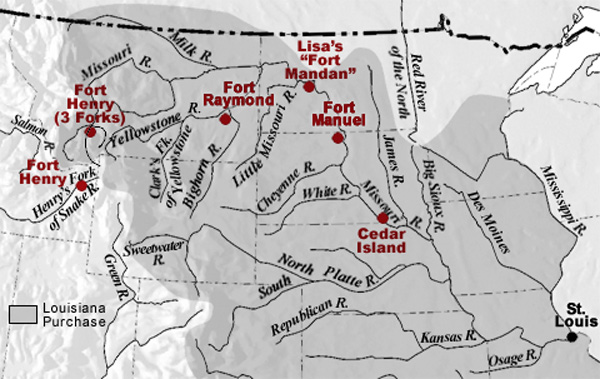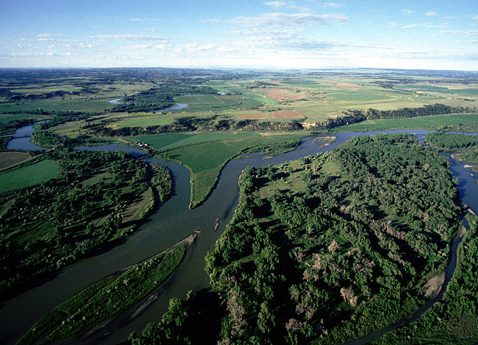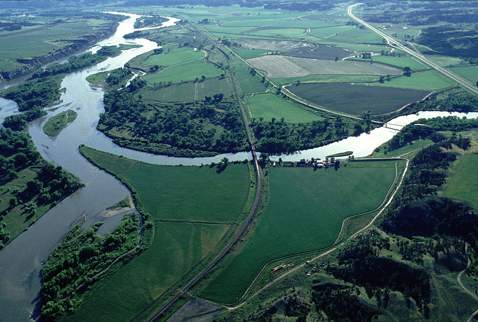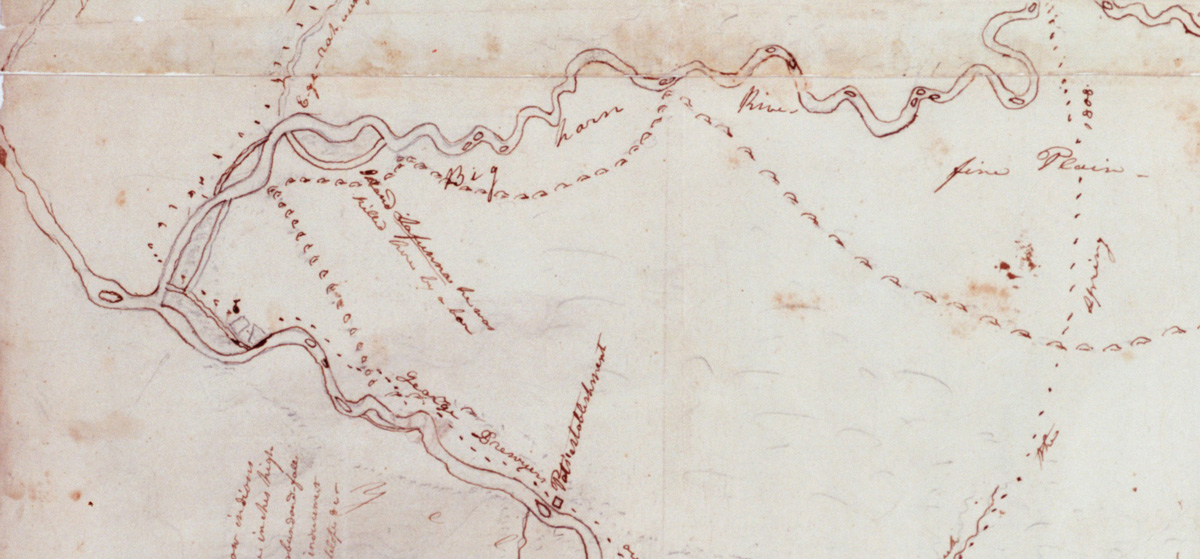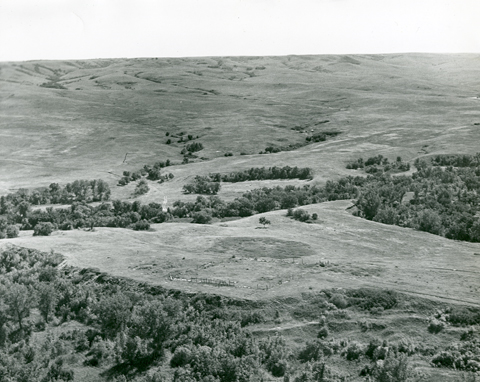Manual Lisa was one of the first traders to follow the Lewis and Clark Expedition up the Missouri and Yellowstone rivers. Potts, Drouillard, and Colter, while trapping near Lisa’s Fort Raymond, encountered difficulties with the Blackfeet. Colter’s story would become one of the greatest tales of the American West. For the other two, the encounter would be fatal.
St. Louis Beginnings
The year was 1807: The growing city of St. Louis had seen the triumphant return of Lewis and Clark in the fall of 1806, and its resident fur traders had been regaled by veterans of that trip with stories about the abundance of fur-bearers on the upper Missouri and the Yellowstone Rivers—especially beavers. Traders had been exploiting the resources of the lower Missouri River for decades. But the abundance of beavers on the upper Missouri was something new and different, and the northern latitudes meant their furs were more luxuriant than those of their watery cousins in the more temperate country along the lower Missouri. This information stirred the city’s traders, but the news especially excited the ambitious and highly energetic Manuel Lisa, who in later years told William Clark that “I put into my operations great activity. I go a great distance while some are considering whether they will start today or tomorrow.”[1]Hiram Martin Chittenden, The American Fur Trade of the Far West, 2 vols. (Stanford, California: Academic Reprints, 1954), 1:30.
Small groups of St. Louis-based traders had gone far up the river, well into present-day Nebraska, Iowa, and Kansas in the 1700s, but their returns had been modest. Now, the newly revealed beaver country led entrepreneur Manuel Lisa to conjure up images of the riches to be obtained in that distant wilderness. Born in New Orleans, Manuel Lisa (1772-1820) came to Spanish St. Louis in about 1798 from Vincennes, where he had been a trader and storekeeper. His efforts to break into the trading circles of the city, initially frustrated, were circumvented by his Spanish instincts to enable him to obtain a trade contract for the Osage Indians, but the move made him highly unpopular with the French-dominated businessmen who monopolized the trade of the lower Missouri. Meriwether Lewis, on the eve of his own expedition’s departure, expressed his disgust with Lisa and his business partner, Francis Marie Benoit: “Damn Manuel and triply Damn Mr. B. They give me more vexation and trouble than their lives are worth.”[2]Lewis to Clark, 6 May 1804, Jackson, Letters, 1:180. The feeling was mutual, although Lisa was more restrained—and more specific—in his opinion of Lewis, which he expressed to Thomas Nuttall in … Continue reading Embedded local interests soon frustrated his trade, however, and profits diminished. These losses were only partly recouped when he provided supplies for the Lewis and Clark expedition, but a lasting benefit was that he probably became acquainted with some of its members in doing so.[3]Richard Edward Oglesby, Manuel Lisa and the Opening of the Missouri Fur Trade (Norman: University of Oklahoma Press, 1963), 29-30.
In 1806, Lisa teamed up with local businessman Jacques Clamorgan and laid plans for a trading expedition to Santa Fe. Though this scheme never materialized, Lisa retained an interest in doing business with his former but distant Spanish countrymen there. Instead, inspired by the stories of furs in the vicinity of the Rocky Mountains, he entered into a partnership with two successful merchants in Kaskaskia, Pierre Menard and William Morrison, to equip and send an expedition up the Missouri to tap into this bonanza.
Lisa’s Fort Raymond
View of the confluence of the Yellowstone and Bighorn Rivers, looking toward the southwest. The site of Fort Raymond would have been somewhere near the center of the photo, probably along the rim of the high terrace.
The confluence of the Yellowstone and Bighorn Rivers viewed toward the northeast. Fort Raymond may have been on the bluff at bottom center. However, the Yellowstone, like the Missouri, sometimes changed its channel, especially at the mouths of tributaries such as the Big Horn, making the location of old historic sites problematic.
In the spring of 1807, Lisa led a party of 50 or 60 men (including Corps of Discovery veterans George Drouillard, John Potts, and Peter Weiser) upriver in two keelboats. On their way they met John Colter, who had left the Lewis and Clark expedition on its way home, to join two American hunters who were bound for the Rocky Mountains. He promptly abandoned his downriver return trip and joined Lisa’s party, surely to Lisa’s delight. His knowledge of the eastern Rockies would be invaluable to the party as they entered new country. In mid-November the group reached the confluence of the Yellowstone and Bighorn Rivers, some twenty miles downstream from Pompeys Pillar, and began the construction of Fort Raymond, named after Lisa’s infant son.[4]Son of Polly Chew Lisa, Manuel’s first wife. Raymond died in July 1811 at the age of five. Walter B. Douglas, Manuel Lisa, annotated and edited by A. P. Nasatir (New York: Argosy-Antiquarian, … Continue reading Perhaps it was Colter who suggested building a post at this location, for his knowledge of the country obtained from his prior experiences trapping in the Rockies would have told him this was near the wintering grounds of the Crow Indians. The lowlands provided ample timber for building the fort, and heat for the winter was available in the form of low-grade coal nearby.
Temporary quarters were erected as the men began to build Fort Raymond in the angle between the mouth of the Bighorn and the Yellowstone Rivers. Set in the middle of Crow Indian country, it would be the first American establishment in the present state of Montana. We have no documentation as to its size or appearance, though the number of men in the group should have enabled them to build a post at least as substantial as Lewis and Clark’s Fort Mandan, if not larger. It was erected in present-day Yellowstone County some 25 miles east of Billings, not far from Exit 49 on Interstate 94. Despite avid searches for its site, no trace of its remains has ever been found. The channels of both rivers have shifted since the fort was built, and the mouth of the Bighorn apparently has moved upstream, perhaps removing any remains of the post.[5]Personal communication, Kenneth Feyhl, Billings, Montana, 3 May 2007.
Colter and Drouillard’s Contributions
Colter was not among those building the fort. Because of the impending winter and because the fall hunting season was over, Lisa’s hunters became carpenters, and the Spaniard promptly sent Colter out (alone and on foot!) to inform local Indians that he was there prepared to trade, for the Crow Indians were already familiar with the white man’s desire for furs. Canadian North West Company trader François-Antoine Larocque had visited the Billings area in the company of a group of Crow Indians in September of 1805—preceding William Clark’s visit to the vicinity during his descent of the Yellowstone by almost a year! There, Larocque had told the Crows that he “desired them to kill Beavers and Bears all winter for that I would come and trade with them and bring them their wants.”[6]W. Raymond Wood and Thomas D. Thiessen, “François-Antoine Larocque’s Yellowstone Journal,'” in Early Fur Trade on the Northern Plains (Norman: University of Oklahoma Press, 1985), … Continue reading The Canadian trader had not returned, but Lisa was now there with much the same message.
John Colter went as far south as the Wind River and Jackson’s Hole, Wyoming and thence through part of present-day Yellowstone National Park in a 500-mile trek through snow-mantled mountains in the dead of winter. He returned in the spring of 1808. Unfortunately he left us no written account or map of his travels, although sometime after he returned to St. Louis in 1810 he helped General Clark trace his route on the map that was to be published in 1814 with Biddle’s paraphrase of the captains’ journals. Colter’s stories of the thermal marvels of the future park would lead to them being called “Colter’s Hell.”[7]Burton Harris, John Colter, His Years in the Rockies (Lincoln: University of Nebraska Press, 1933), traces his route through this wilderness. George Drouillard, on the other hand, made two trips to the south and east of Fort Raymond, first visiting Indian groups in the Bighorn Basin, and later travelling through much of north-central Wyoming.
Figure 4
Drouillard-Clark 1808 Map of the Bighorn Country [detail]
To see labels, point to the image.
Courtesy Missouri Historical Society, D00469, mohistory.org/collections/item/D00469.
Detail from the now-faded sketch map William Clark pencilled using information from Drouillard’s travels. The chart shows the location of Fort Raymond, “Pott establishment,” and Drouillard’s route in 1807-1808. It includes numerous notes, including one (not shown) that gives the direction and travel time to Spanish settlements in the Southwest.
During the winter Lisa’s hunters brought in sufficient furs to confirm the Spaniard’s expectations of riches from the region. In high spirits, Lisa returned to St. Louis that summer to expand his operations, taking Drouillard with him. Drouillard met there with William Clark, and on 5 August Drouillard created a pencil sketch map of the country he had traversed upriver. More importantly, using this new information, Clark penned a great map of Drouillard’s explorations in the Yellowstone-Bighorn area, vastly elaborating the pencil sketch. Both of these eyewitness maps depict the location of Fort Raymond.[8]Jeffery R. Hanson, “The George Drouillard Maps of 1808,” Archaeology in Montana, Vol 21, No. 1 (1980), 45-53. Clark incorporated this information in his monumental manuscript map of 1810—the one that Samuel Lewis engraved for the 1814 Biddle edition of the Lewis and Clark expedition. Clark included a symbol for “Manuels Fort in 1807” on the manuscript map and Samuel Lewis retained it on the engraved version.
That map also carries a small square on the south bank of the Yellowstone a few miles upstream from the mouth of the Bighorn labeled only as “Pott establishment.” If Potts had any kind of establishment at this place contemporary references are silent on the matter.
Lisa’s Fort Mandan
Lisa’s explosive news on his return now convinced the merchants in St. Louis that he truly had opened the doors to new wealth, and they joined him in 1808-1809 to found the St. Louis Missouri Fur Company, electing William Clark as its president. That spring saw the first expedition of the fledgling company leaving St. Louis for the upper Missouri. Great returns were expected for, in addition to its anticipated return in furs, they had a $7,000 contract with Governor Meriwether Lewis to return Chief Sheheke (Big White), to his people, the Mandans. The chief and his wife had returned to Washington with Lewis and Clark, and efforts to return them to their people had to this point been frustrated. This goal was, however, now realized and the chief was warmly received by his people, for they believed he had died.
The second expedition was much larger and better financed, and initially consisted of 13 rivercraft. Lisa was accompanied by most of his new partners, including Meriwether Lewis’s brother Reuben, and the fur-trade’s legend-to-be, Andrew Henry. His men built a new post a few miles upstream from the Mandan and Hidatsa villages on the Knife River. Often called Fort Mandan, it was about ten miles upriver from Lewis and Clark’s fort of the same name. (Its exact location is unknown despite careful searches for its remains.) An eyewitness description of the fort in June 1811 by John Bradbury is worth quoting, for it corresponds to the architecture of other such posts built at the time and may reflect something of the nature of Fort Raymond:
The fort consisted of a square blockhouse, the lower part of which was a room for furs: the upper part was inhabited by Mr. [Reuben] Lewis and some of the hunters belonging to the establishment. There were some small outhouses, and the whole was surrounded by a pallisade, or piquet, about fifteen feet high. I found attached to it a very pretty garden.[9]John Bradbury, Travels in the Interior of North America in the Years 1809, 1910, and 1811 (London: Sherwood, Neely, and Jones, 1817), 143.
Figure 5
A Blackfoot Indian on Horse-back
Karl Bodmer (1809–1893)
Rare Book Division, The New York Public Library.[10]“Blackfoot Indianer zu Pferd. Indien Pieds Noir à cheval. A Blackfoot Indian on horse-back.” New York Public Library Digital Collections. Accessed 14 December 2020. … Continue reading
The Blackfeet People dominated the eastern rim of the Rocky Mountains and were determined foes of the mountain men. They violently opposed the Americans who trapped their own furs and thereby excluded them from the trade.
Hostilities: Colter, Potts, and Drouillard
In the spring of 1810 Andrew Henry and Pierre Menard, led by John Colter, left Fort Raymond with a group of men and went to the Three Forks of the Missouri, where they built Fort Henry. They then crossed over Bannock Pass into present-day Idaho, where they established a second post on Henry’s Fork of the Snake River, also called Fort Henry. Both forts were short-lived: Fort Henry at the Three Forks was abandoned after a few months because of continuously hostile encounters with the Blackfeet, and Fort Henry on Henry’s Fork closed down the following year.
The men in the Three Forks country had again tempted the Blackfeet to resist them. They did. The men were killed and robbed by the Blackfeet, and the luckless trappers were expelled from the region nearly empty-handed. Among those killed were two veterans of the Corps of Discovery, George Drouillard and John Potts. As they trapped together in the fall, Colter and Potts had been surprised by a large party of Blackfeet and Potts was killed immediately. Captured, stripped naked, and challenged to run for his life, Colter did so and not only escaped his pursuing tormenters, but he made the 250-mile trip back to Fort Raymond on bare feet, an episode that entered western lore as “Colter’s Run.”
Menard returned to St. Louis in the summer of 1810, telling Lisa of the abandonment of Fort Henry at the Three Forks and other losses. But it was not until April that Lisa was able to send a relief expedition to his men on the upper Missouri. They found that in their absence the men at Fort Raymond had accumulated a good stock of prime furs, and Henry and Lisa returned to St. Louis with high hopes. Nonetheless, they reorganized their assets in a new company, named the Missouri Fur Company. Lisa’s next expedition up the Missouri was made in May under the threat of war between the United States and Great Britain. Despite this cloud, two posts were built on the Missouri River: one for the Sioux at Cedar Island, in present southeastern South Dakota, and another for the Arikaras, generally called Fort Manuel, a few miles south of the North Dakota and South Dakota boundary (today both have been flooded or destroyed by federal reservoirs, Lake Francis Case and Lake Oahe).
Luttig’s Narratives
The site of Fort Manuel as it appeared in the summer of 1956. The deteriorating fence marking the original stockade around its perimeter was erected about 1941 by the Bureau of Indian Affairs and the Civilian Conservation Corps. Photograph by W. Raymond Wood (Courtesy of the State Historical Society of North Dakota).
Lisa’s upriver journey was chronicled by one of his men. John C. Luttig, a clerk, or business manager, for the Missouri Fur Company, provides a rich narrative of events as Fort Manuel was being built and trading commenced. One of the engagés with Lisa was Toussaint Charbonneau, accompanied by his Lemhi Shoshone wife. Luttig records that Sacagawea died of a “putrid fever” there on 20 December 1812.[11]John C. Luttig, The Journal of a Fur-Trading Expedition on the Upper Missouri, 1812-1813, ed. Stella M. Drum (St. Louis: Missouri Historical Society, 1920), 106. The site of Fort Manuel was excavated before it was destroyed by wave action of Lake Oahe, and the work revealed details of its construction that might have a bearing on Lisa’s first post, Fort Raymond. The buildings at Fort Manuel were enclosed by a quadrilatral stockade of upright posts set in a shallow trench, and was reinforced by circular bastions in two corners that also were composed of upright posts.[12]G. Hubert Smith and Jon Ludwickson, Fort Manuel: The Archeology [sic] of an Upper Missouri Trading Post of 1812-1813. South Dakota Archaeological Society, Special Publication, 7, 71. Circular bastions are not recorded for any other post on the upper Missouri; indeed, John Bradbury wrote that Lisa’s Fort Mandan had “a square blockhouse.”
Trade was still being conducted at Lisa’s Fort Mandan, and the fort apparently continued in use through August of 1812, but it was abandoned shortly thereafter.[13]Wood and Thiessen, Early Fur Trade, 34, note 55. There is no mention in Luttig’s journal of activities at Fort Raymond.
Matters were becoming increasingly unsettled on the upper Missouri and unrest among the Indians was fanned by the British after the outbreak of the War of 1812 in June. By March 1813, Lisa abandoned Fort Manuel and retreated to Cedar Island, and in May he returned to St. Louis. Luttig’s journal ends before the abandonment of Fort Manuel, so its last days are not recorded, but the post ultimately was destroyed by fire, perhaps set by the Sioux.[14]Smith and Ludwickson, Fort Manuel, 80. Undoubtedly Fort Raymond also saw the last of its occupants as Lisa’s men fled back to St. Louis if, indeed, it was still in operation. Surely Lisa would have ordered its abandonment as he himself withdrew from the upper Missouri, leaving Fort Manuel to its fate. Its four-month period of occupancy made it—like Fort Henry at the Three Forks—among the shortest-lived posts on the upper Missouri.
Closing
The first western outpost of the coming fur trade lasted for only six years, but it set the standard for more successful enterprises on the upper Missouri. Lisa’s men at Fort Raymond not only encouraged the Crows to come trade with them, but they set out parties to trap beaver on their own. It was the latter effort that led to hostilities with the Blackfeet, who resented this theft of goods from their territory. John Potts may have run a small post a few miles upriver from Fort Raymond, but major efforts were made to establish Fort Henry at the Three Forks, and a second Fort Henry on the Snake River. Blackfeet hostility led to their abandonment within a few months. Fort Raymond was a lonely outpost, 2000 miles from home, enlivened principally by the stories told by men returning from hazardous excursions, Colter’s stories of what his incredulous audience called “Colter’s Hell” and his escape from the Blackfeet, and other close calls—and the death—of colleagues. The news they were to abandon the post in the spring of 1813 must have been met with relief by its inhabitants.
The winter’s proceeds on the river did not repay the company’s outlay for this expedition for, in addition to other problems, the value of beaver pelts had dropped to only $2.50 a pound. Lisa was quickly replaced on the board of directors by Pierre Chouteau, and the short-lived St. Louis Missouri Fur Company was dissolved on 17 January 1812. With William Clark’s assistance, Lisa managed to fund yet another assault on the river in 1814, during which time he is said to have helped keep “the western tribes loyal to the United States during the War of 1812.”[15]Oglesby, Manuel Lisa, 152-60. In 1816 the Spaniard partnered with former fur trade rival Theodore Hunt in yet another venture, but this too terminated a year later. Moving from one unsuccessful business to another, he arrived in St. Louis in the spring of 1820 so sick that he called in a laywer to put his affairs in order. His illness led him to seek relief in a local sulphur spring, where he died on 11 August 1820. His grave may be found today in Bellefontaine Cemetery in north St. Louis, not far from that of William Clark.
Though ultimately unsuccessful in his quest for wealth on the upper Missouri, Lisa “laid down the principles for the successful operation of the fur trade in that area.”[16]Ibid., 195. Later entrepeneurs were to follow his lead and one of them, John Jacob Astor, did indeed become very rich, though many other aspirants had short and unproductive years on the river. Lisa’s remarkable energy carried him up the Missouri River at least a dozen times, and Hiram Chittenden notes that he traveled the river nearly 26,000 miles—more than the circumference of the earth![17]Chittenden, American Fur Trade, 1:129. Though his unbounding energy was not crowned with success, Fort Raymond set the stage for what was to come in the American fur trade in the far west.
Further Reading
Harris, Burton. 1933. John Colter: His Years in the Rockies. Lincoln: University of Nebraska Press.
James, Thomas. 1984. Three Years Among the Indians and Mexicans. Lincoln: University of Nebraska Press.
Lavender, David. 1964. Fist in the Wilderness. Garden City, N.Y.: Doubleday.
Thiessen, Thomas D. 1993. “Historic Trading Posts Near the Mouth of the Knife River.” In The Phase I Archeological Research Program for the Knife River Indian Villages National Historic Site, Part II: Ethnohistorical Studies. Lincoln: Midwest Archeological Center, pp. 47-74.
Utley, Robert M. 1997. A Life Wild and Perilous: Mountain Men and the Paths to the Pacific. New York: Henry Holt.
Wishart, David J. 1979. The Fur Trade of the American West, 1807-1840. Lincoln: University of Nebraska Press.
Notes
| ↑1 | Hiram Martin Chittenden, The American Fur Trade of the Far West, 2 vols. (Stanford, California: Academic Reprints, 1954), 1:30. |
|---|---|
| ↑2 | Lewis to Clark, 6 May 1804, Jackson, Letters, 1:180. The feeling was mutual, although Lisa was more restrained—and more specific—in his opinion of Lewis, which he expressed to Thomas Nuttall in Pittsburgh in 1810. Nuttall, in a letter to Benjamin Smith Barton, quoted Lisa as having said that Lewis was “fond of exaggerating everything relative to his expedition, & . . . a very headstrong, & in many instances an imprudent man.” Nonetheless, Clark may have hired several of Lisa’s men to assist with the boats (ibid., 1:168), and Lewis wasn’t above asking Lisa to try raising some young bighorn sheep, and Lisa made a serious effort (ibid., 1:241). |
| ↑3 | Richard Edward Oglesby, Manuel Lisa and the Opening of the Missouri Fur Trade (Norman: University of Oklahoma Press, 1963), 29-30. |
| ↑4 | Son of Polly Chew Lisa, Manuel’s first wife. Raymond died in July 1811 at the age of five. Walter B. Douglas, Manuel Lisa, annotated and edited by A. P. Nasatir (New York: Argosy-Antiquarian, Ltd., 1964), 111. |
| ↑5 | Personal communication, Kenneth Feyhl, Billings, Montana, 3 May 2007. |
| ↑6 | W. Raymond Wood and Thomas D. Thiessen, “François-Antoine Larocque’s Yellowstone Journal,'” in Early Fur Trade on the Northern Plains (Norman: University of Oklahoma Press, 1985), 156-59, 192. |
| ↑7 | Burton Harris, John Colter, His Years in the Rockies (Lincoln: University of Nebraska Press, 1933), traces his route through this wilderness. |
| ↑8 | Jeffery R. Hanson, “The George Drouillard Maps of 1808,” Archaeology in Montana, Vol 21, No. 1 (1980), 45-53. |
| ↑9 | John Bradbury, Travels in the Interior of North America in the Years 1809, 1910, and 1811 (London: Sherwood, Neely, and Jones, 1817), 143. |
| ↑10 | “Blackfoot Indianer zu Pferd. Indien Pieds Noir à cheval. A Blackfoot Indian on horse-back.” New York Public Library Digital Collections. Accessed 14 December 2020. https://digitalcollections.nypl.org/items/510d47da-c401-a3d9-e040-e00a18064a99. |
| ↑11 | John C. Luttig, The Journal of a Fur-Trading Expedition on the Upper Missouri, 1812-1813, ed. Stella M. Drum (St. Louis: Missouri Historical Society, 1920), 106. |
| ↑12 | G. Hubert Smith and Jon Ludwickson, Fort Manuel: The Archeology [sic] of an Upper Missouri Trading Post of 1812-1813. South Dakota Archaeological Society, Special Publication, 7, 71. |
| ↑13 | Wood and Thiessen, Early Fur Trade, 34, note 55. |
| ↑14 | Smith and Ludwickson, Fort Manuel, 80. |
| ↑15 | Oglesby, Manuel Lisa, 152-60. |
| ↑16 | Ibid., 195. |
| ↑17 | Chittenden, American Fur Trade, 1:129. |
Experience the Lewis and Clark Trail
The Lewis and Clark Trail Experience—our sister site at lewisandclark.travel—connects the world to people and places on the Lewis and Clark Trail.
Discover More
- The Lewis and Clark Expedition: Day by Day by Gary E. Moulton (University of Nebraska Press, 2018). The story in prose, 14 May 1804–23 September 1806.
- The Lewis and Clark Journals: An American Epic of Discovery (abridged) by Gary E. Moulton (University of Nebraska Press, 2003). Selected journal excerpts, 14 May 1804–23 September 1806.
- The Lewis and Clark Journals. by Gary E. Moulton (University of Nebraska Press, 1983–2001). The complete story in 13 volumes.
